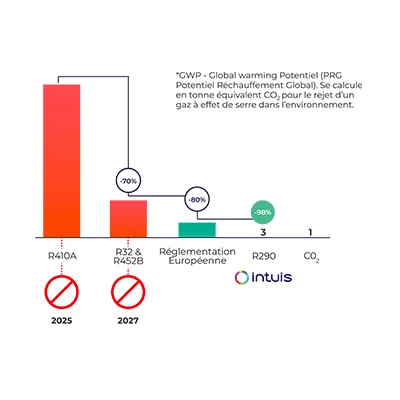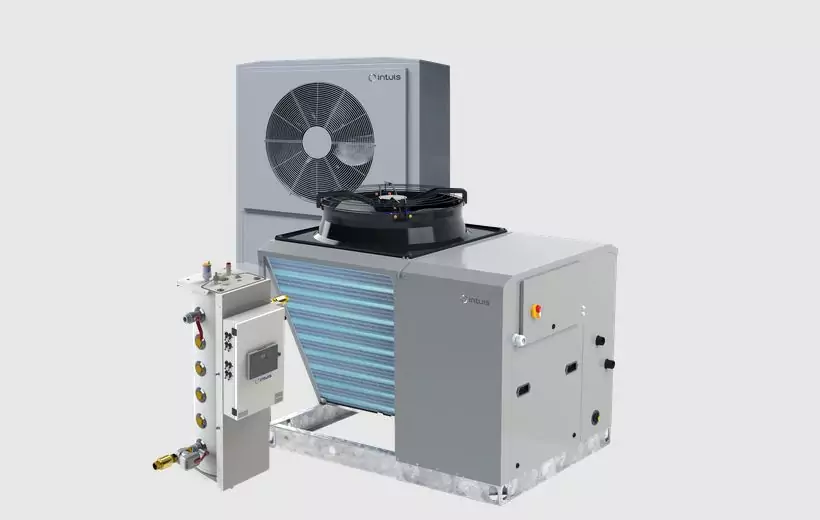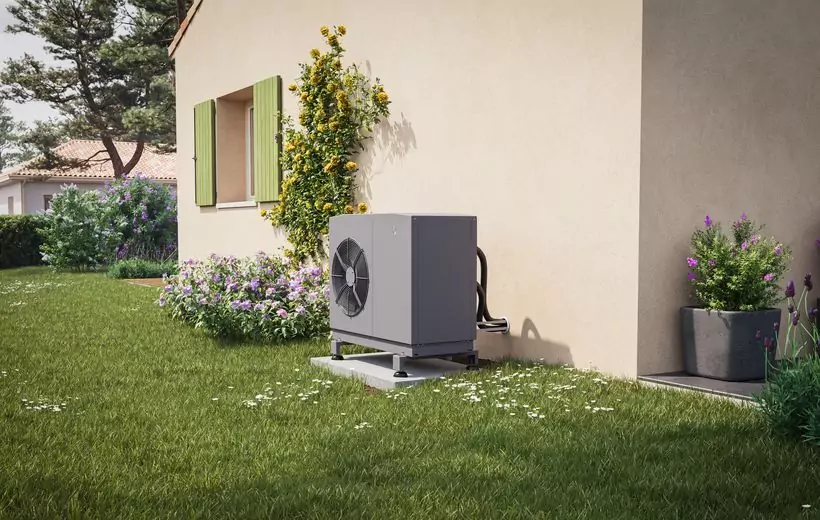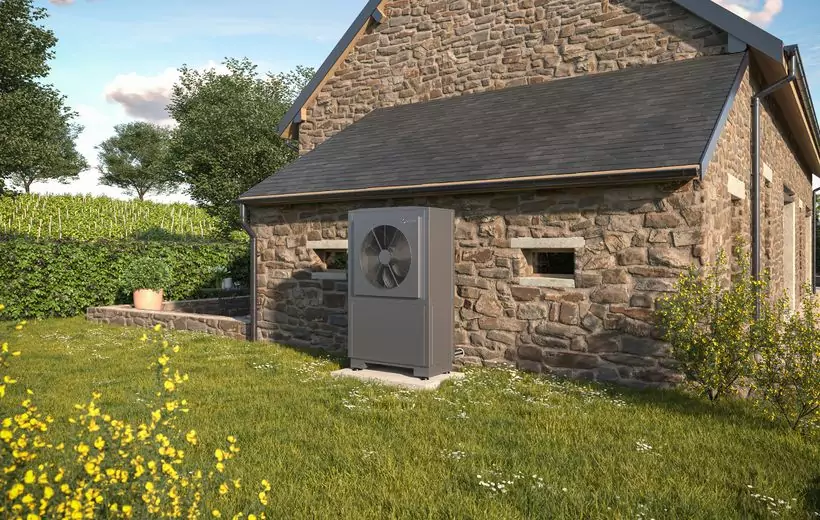

Table of contents

Table of contents
Introduction
The use of hydrofluorocarbons (HFCs) is regulated within the European Union by the F-Gas regulation, which gradually restricts certain equipment using refrigerants with a high global warming potential (GWP).
In early October 2023, the European Commission agreed on new provisional agreements that strengthen the ban on placing products containing fluorinated gases on the market.
The F-Gas regulation, aimed at reducing greenhouse gas emissions, particularly impacts the HVAC (heating, ventilation, air conditioning) sector. These agreements were approved by the Council and the European Parliament on January 15, 2024, for definitive implementation in spring 2024.
Air/Water heat pumps and thermodynamic water heaters are emerging as increasingly suitable options. To operate, heat pumps and thermodynamic water heaters require the use of a refrigerant (find our article on how a heat pump works here). The types of refrigerants are evolving to best meet environmental challenges.
The intuis Group, a pioneer in this field, firmly embraces this dynamic by offering high-performance solutions with low environmental impact. Its avant-garde approach is demonstrated by the integration of the R290 refrigerant at the core of its technologies. From the outset, its forward-thinking approach led it to produce only thermodynamic equipment based on the R290 refrigerant with minimal environmental impact.
This article provides insights into the F-Gas regulation, examining its industrial implications. It also explores how the innovative vision of the intuis Group, combined with the use of the R290 refrigerant, underscores our environmental commitment.
What is the F-Gas Regulation?
Applicable since January 1, 2015, the F-Gas Regulation, also known as Regulation (EU) No 517/2014, is part of a global energy transition context aimed at reducing greenhouse gas emissions contributing to climate change.
The F-Gas Regulation relies on the Global Warming Potential (GWP) to determine the impact of the refrigerant on the ozone layer. The higher the GWP, the more harmful the refrigerant is considered to be for the environment.
The GWP value is compared to the CO₂ reference index, which is 1. (For example, 1 kg of R410A emitted equals 2088 kg of CO₂ emitted, which is equivalent to the total CO₂ emissions of a vehicle driving 14,000 km with an average emission of 150 g/km).
Considering that a split heat pump operating on R410A contains several kilograms of refrigerant, the implications can be significant in case of leaks.
To achieve its goal, the F-Gas Regulation conditions the use and placing on the market of equipment containing fluorinated refrigerants, limiting the impacts of greenhouse gases.

Illustration of the main objectives of the F-Gas Regulation:
- Total ban on HFCs by 2050
The regulation provides for a complete ban on hydrofluorocarbons (HFCs), the largest family of F gases, by 2050. This ban will be implemented progressively, with reductions in stages.
- Promotion of environmentally friendly solutions
The objective is to promote the development and use of environmentally friendly technologies to gradually replace F gases (or fluorinated gases, which have a strong environmental impact) in various industrial and domestic applications.
(Source: Council of the European Union)
The F-Gas Regulation thus provides for several significant measures:
- Mandatory training for individuals working with all types of refrigerants. This includes those not covered by the F-Gas Regulation, such as R290 and other hydrocarbons.
- Quotas for refrigerants subject to the F-Gas Regulation become payable for manufacturers, and their reduction will make maintenance of equipment containing them more complex.
- Promotion of refrigerant recovery and recycling.
- Enhanced control of refrigerant movements and their traceability to reduce illegal trade.
- Mandatory annual leak testing.
Good to know: What is refrigerant fluid?
Refrigerant fluid is an essential component in the operation of a heat pump or a thermodynamic water heater. Whether in liquid or gaseous form, it carries the calories extracted from the air to the heating circuit.
Current provisions regarding F-Gas
The F-Gas regulation aims to reduce the use of refrigerants with high Global Warming Potential (GWP) in heat pumps and thermodynamic water heaters.
Since 2015, F-Gas has already prohibited the placing on the market of several refrigerants deemed harmful to the environment, thus pushing manufacturers to turn to more environmentally friendly alternatives.
And by 2030, the goal of F-Gas is to drastically reduce CO2 emissions and compel the HVAC sector to opt for less polluting refrigerants in heat pump systems and thermodynamic water heaters.
Find in this summary table an overview of refrigerants on the market.
Banned in 2020
| FLUIDES | COMPOSITION | PRG | CATÉGORIE |
| R-404A | R125(44%) – R143a(52%) – R134a(4%) | 3922 | A1 |
| R422D | R125(65,1%) – R134a(31,5%) – R600a(3,4%) | 2729 | A1 |
| R22 | Fluide pur (Chlorodifluorométhane) | 1810 | A1 |
Banned between 2022 and 2025
| FLUIDES | COMPOSITION | PRG | CATÉGORIE |
| R407F | R32(30%) – R125(30%) – R134a(40%) | 1825 | A1 |
| R407C | R32(23%) - R125(25%) - 134a(52%) | 1774 | A1 |
| R410A | R32(50%) – R125(50%) | 2088 | A1 |
| R452A | R32(11%) – R125(59%) – R1234yf(30%) | 2141 | A1 |
Banned from 2027
| FLUIDES | COMPOSITION | PRG | CATÉGORIE |
| R32 | Fluide pur (Difluorométhane) | 675 | A2L |
| R134a | Fluide pur (1,1,1,2-tétrafluoroéthane) | 1430 | A1 |
| R448A | R32(26%) – R125(26%) – R1234yf(20%) – R134a(21%) – R1234ze(7%) | 1387 | A1 |
| R449A | R32(24,3%) – R125(24,7%) – R1234yf(25,3%) – R134a(25,7%) | 1397 | A1 |
| R513 | R1234yf(56%) – R134a(44%) | 631 | A1 |
| R452A | R32(67%) – R125(7%) – R1234yf(26%) | 698 | A2L |
Available until 2030
| FLUIDES | COMPOSITION | PRG | CATÉGORIE |
| R454A | R32(21,5%) – R1234yf(78,5%) | 148 | A2L |
| R-1234ze | Fluide pur (Trans-1,3,3,3-tétrafluoroprop-1-ène) | 7 | A2L |
| R-1234yf | Fluide pur (2,3,3,3-tétrafluoroprop-1-ène) | 4 | A2L |
| R290 | Fluide pur (propane) | 3 | A3 |
| R600a | Fluide pur (isobutane) | 3 | A3 |
| R744(CO2 | Fluide pur (dioxyde de carbone) | 1 | A1 |
| R717 | Fluide pur (ammoniac) | 0 | B2L |
| R718 | Fluide pur (eau) | 0 | A1 |
How are the fluids evaluated ?
To understand the classification of fluids properly, there are two major criteria for classifying fluids: 1/ safety and 2/ environmental impact.

Toxicity:
A: Low toxicity
B: Toxic

Flammability:
Group 1: Non-flammable
Group 2: Flammable
Group 2L: Low flammability
Group 3: Highly flammable

Operating Pressure
High
Low

GWP Indicator
What about intuis heat pumps ?
intuis monobloc heat pumps use R290, a Group 3 refrigerant, with low toxicity, low operating pressure, and a GWP indicator of 3.
R290, also known as Propane, serves as an alternative to fluorinated hydrocarbons (F-gases), unlike synthetic refrigerants like R410A and R32, which are known to be harmful to the environment.
Intuis is the only manufacturer offering a range of heat pumps and thermodynamic water heaters 100% using R290.
intuis high-temperature heat pumps, designed and manufactured in France, combine performance and environmental respect through the use of R290 refrigerant. With a GWP of 3, R290 aligns well with the goals set by F-Gas regulations.
This innovative choice dates back 15 years, distinguishing intuis as a pioneer in this technological decision. Unlike R32 (GWP 675), more commonly used in heat pump systems, R290 (GWP 3) is not subject to F-Gas regulations.
Advantages of intuis heat pumps:
Design: No fluid manipulation. It's hermetically sealed from the factory in the outdoor unit, making the refrigeration circuit airtight with no contact with the water circuit. This also reduces installation costs. R290 also ensures durability, devoid of any detachable connections, eliminating the risk of leakage or the need for recharging. This ensures consistent performance over time without degradation, as there's no gas loss.
Safety : intuis heat pumps using R290 use very little refrigerant (less than 1kg), whereas R410A or R32 heat pumps are loaded with over 2kg* of fluid in their systems. The amount of fluid is significant because it determines how often the equipment needs to be checked. For heat pumps with over 2kg, it's mandatory to have the equipment checked annually; below that, there's no regulatory obligation.
Performance : The high temperature of our HTi70 and HRC70 heat pumps is made possible by R290, which can reach departure temperatures of 70°C even in extreme cold. No need to change radiators. They also adapt to underfloor heating to ensure consistent comfort and energy savings (Coefficient of Performance or COP greater than 3), without the need for electric backup.
Cost : The scarcity of heat pump systems using refrigerants with a high GWP will force individuals to adapt their equipment, whereas Intuis offers a sustainable thermodynamic solution.
* Depending on models, power, and brands.
Good to know : The cost of a professional intervention to recharge the circuits with refrigerant can range from €150 to €450 excluding tax per kilogram of replaced refrigerant (source: Effy).
Important point: Like any refrigerant, R290 is subject to requirements to ensure its safe use.

The next deadlines
In 2035, F-Gas foresees a complete ban on all air/water and air/air heat pumps containing fluorinated gases.
Conclusion
The current provisions of the F-Gas regulation aim to replace all synthetic fluids with high global warming potential with fluids like R290.
As a true visionary in energy transition, intuis made the early choice of R290, which has a low environmental impact.
Leveraging its expertise and experience, intuis provides solutions exempt from the European F-Gas Regulation.





